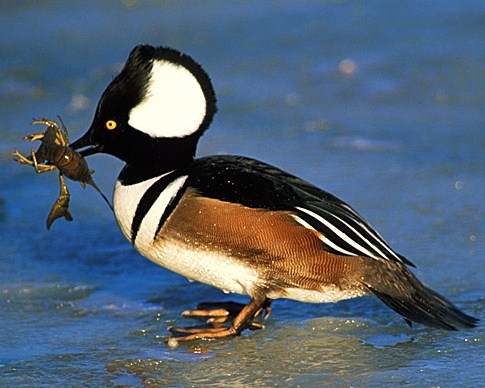Lophodytes cucullatus
 |
| Photo by Bill Horn (Birds of Oklahoma) |
Common name:
hooded merganser (en); merganso-capuchinho (pt); harle couronné (fr); serreta capuchona (es); kappensäger (de)
Taxonomy:
Order Anseriformes
Family Anatidae
Range:
This North American species breeds across mots of the eastern United States, in the north-western united States and across most of southern Canada. Some populations migrate south to winter along the coast of California and along the Atlantic coast from Delaware to Texas.
Size:
Hooded mergansers are 40-49 cm long and have a wingspan of 60-66 cm. They weigh 450-880 g.
Habitat:
They are generally found breeding in forested wetlands, namely spruce/fur to cottonwood/elder and oak/cypress/tupelo. They can also breed in wet grasslands and sometimes in open wetlands. During winter they prefer shallow, freshwater and brackish bays, estuaries, and tidal creeks and ponds.
Diet:
Hooded mergansers are mostly carnivorous, eating fishes, aquatic insects and crustaceans. They sometimes also eat aquatic plants.
Breeding:
These birds breed in February-June. The female selects the nest site, which is usually a cavity in a dead or live tree, or sometimes a man-made nest box. The nest is usually 1,5-5 m above the ground. There the female lays 6-15 glossy white eggs which she incubates alone for 26-41 days. Within 24 h or hatching the female leads the ducklings to water and they remain with their mother until fledging which takes place 70 days later. Each pair raises a single clutch per year.
Conservation:
IUCN status – LC (Least concern)
This species has a very large breeding range and a global population estimated at 270.000-390.000 individuals. The population has undergone a large increase over the last 40 years, equating to a 85,9% increase per decade.







